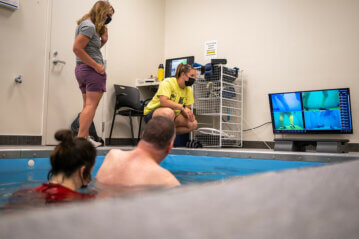Exercise is hard. At the end of it all, we’re sure to be left breathless and fatigued, with residual soreness or pain. We take our aspirin or ibuprofen seeking relief, and we do it all again in the name of health.
After suffering a brain or spinal cord injury, the demands put on bodies to facilitate recovery are tenfold. Contractures, loss of function, and deconditioning can make what was once challenging but doable seemingly impossible. Fortunately, advances in technology have proffered a variety of therapeutic interventions to keep the gains toward recovery consistent and viable, while minimizing physical stress and pain.
The HydroWorx® company is based out of Pennsylvania and has had numerous successes in creating water-resistance therapeutic devices for over 50 years. The HydroWorx® prototype acted as a treadmill for clients to build up their leg strength as a form of resistance training. The family of products all incorporate this basic function.
One of the first steps in physical rehabilitation is weight-bearing and mobility training. To do so on a 
In 2013, when building the Gait and Robotics Lab, QLI partnered with HydroWorx® to create a system customized to the individuals and diagnoses we serve. QLI’s HydroWorx® provides the functions and benefits of an underwater treadmill while incorporating the rehabilitation technique of biofeedback. The client enters the system by walking or being rolled directly onto a treadmill platform. Support bars run alongside to provide stability. With the press of a button, the platform then lowers the user into the heated water at the appropriate height for the planned exercise. For example, in a simple ambulation exercise, the therapist programs the treadmill to lower to 75% of the user’s height to allow for some gravitational weight to be lifted. Maxing out at six foot depth, the HydroWorx® is equipped to meet virtually any needs of the client regardless of height. Many features of the device are controlled with a detailed remote.
Unique to QLI’s system is a four-camera setup on each side of the room surrounding the HydroWorx®. A live feed is shown on a television positioned on a wall facing the device, which allows both therapist and user to identify in real-time any buckling, swaying, inconsistent gait patterns, and other abnormalities in real time. Additionally, with cameras filming every session, clients have a marker on which to view their progress.
Moreover, the process of aquatic therapy is relaxing for the client, relieving pain while keeping them guided toward physical progress. Should a client practice gait and stride training on a treadmill—even with an over-ground body weight support ambulation system there is a defined limit to what can be done in a given session, because of fatigue or pain that may arise. The HydroWorx® has an inherent range that allows for these numerous disciplines to be explored all within an hour or less.
The HydroWorx® provides clients with a unique experience that not only allows them to yield positive results in gait training and overall injury recovery but does so in a space that may be more amenable to their current strength and ability to exert themselves.
For more information on QLI’s rehabilitation programs, click here.
Categories: Gait Training, HydroWorx, Physical Therapy, Rehabilitation, Stroke
